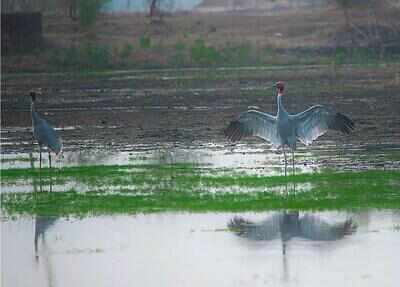- News
- City News
- nagpur News
- Sarus numbers falling further, only 34 in Gondia
Sarus numbers falling further, only 34 in Gondia

A day-long sarus estimation-2022 was conducted by Gondia forest division and NGO Sustaining Environment and Wildlife Assemblage on June 12
Nagpur: Alarm bells are ringing for sarus cranes, the world’s tallest birds that are only found in Gondia and Bhandara districts in the state. In the last three years, their numbers have fallen from 42 to 34 this year.
The result of the day-long sarus estimation-2022, conducted jointly on June 12 by the Gondia forest division and wildlife protection NGO Sustaining Environment and Wildlife Assemblage (SEWA), was announced on Thursday.
Sawan Bahekar, president of the SEWA, said, “The number of sarus cranes in Gondia district is estimated to be 34. In 2020, their number was 42 and in 2020, 37. The decline is not a good sign.”
Gondia and neighbouring Balaghat district in Madhya Pradesh are divided by Bagh and Wainganga rivers and sarus habitat is somewhat similar on both sides. Estimation exercise was done in both places.
It was conducted on June 11 in Balaghat where these birds share overlapping territories with Gondia. Balaghat recorded 45 birds. On June 12, the count was held in Bhandara and Gondia districts. In Bhandara, volunteers of SEAT recorded three sarus cranes.
“Over 42 teams of volunteers fanned the entire district in sarus habitat areas. The exercise was done in a scientific manner and to ascertain the facts and numbers our volunteers also visited the habitat areas from June 13 to 15, before declaring the count,” said Bahekar.
Sarus birds are listed in Schedule IV under the Wildlife Protection Act, 1972, and also listed as ‘vulnerable’ on the International Union for Conservation of Nature (IUCN) Red List.
SEWA has been involved in the conservation of these birds since 2000. It is only after the Nagpur Bench of Bombay High Court took suo motu cognizance of media reports that the forest department got involved officially.
“In the last several years we have been reaching hundreds of farmers to spread awareness about the use of deadly pesticides. We have also roped in many volunteers as ‘sarus friends’ to conserve the birds,” said Chetan Jasaani, one of the coordinators of the exercise.
Jassani added, “The main threat to the sarus cranes in Gondia district is habitat loss and degradation due to shrinking wetlands, sand mining, excessive use of pesticides, electrocution, and encroachments.”
“Recently, the emerging threat is disturbance by photographers to click the birds. There have been also reports of egg stealing. The landscape of its historic range is rapidly changing due to the construction of highways and roads and railway lines too,” said Shashank Ladekar, a volunteer.
The result of the day-long sarus estimation-2022, conducted jointly on June 12 by the Gondia forest division and wildlife protection NGO Sustaining Environment and Wildlife Assemblage (SEWA), was announced on Thursday.
Sawan Bahekar, president of the SEWA, said, “The number of sarus cranes in Gondia district is estimated to be 34. In 2020, their number was 42 and in 2020, 37. The decline is not a good sign.”
Gondia and neighbouring Balaghat district in Madhya Pradesh are divided by Bagh and Wainganga rivers and sarus habitat is somewhat similar on both sides. Estimation exercise was done in both places.
It was conducted on June 11 in Balaghat where these birds share overlapping territories with Gondia. Balaghat recorded 45 birds. On June 12, the count was held in Bhandara and Gondia districts. In Bhandara, volunteers of SEAT recorded three sarus cranes.
“Over 42 teams of volunteers fanned the entire district in sarus habitat areas. The exercise was done in a scientific manner and to ascertain the facts and numbers our volunteers also visited the habitat areas from June 13 to 15, before declaring the count,” said Bahekar.
Sarus birds are listed in Schedule IV under the Wildlife Protection Act, 1972, and also listed as ‘vulnerable’ on the International Union for Conservation of Nature (IUCN) Red List.
SEWA has been involved in the conservation of these birds since 2000. It is only after the Nagpur Bench of Bombay High Court took suo motu cognizance of media reports that the forest department got involved officially.
“In the last several years we have been reaching hundreds of farmers to spread awareness about the use of deadly pesticides. We have also roped in many volunteers as ‘sarus friends’ to conserve the birds,” said Chetan Jasaani, one of the coordinators of the exercise.
Jassani added, “The main threat to the sarus cranes in Gondia district is habitat loss and degradation due to shrinking wetlands, sand mining, excessive use of pesticides, electrocution, and encroachments.”
“Recently, the emerging threat is disturbance by photographers to click the birds. There have been also reports of egg stealing. The landscape of its historic range is rapidly changing due to the construction of highways and roads and railway lines too,” said Shashank Ladekar, a volunteer.
FOLLOW US ON SOCIAL MEDIA
FacebookTwitterInstagramKOO APPYOUTUBE
Looking for Something?

Start a Conversation
end of article










